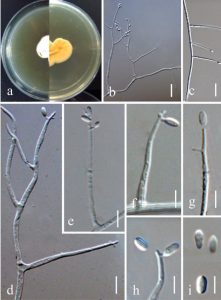Calcarisporium cordycipiticola Jing Z. Sun, Cai H. Dong, Xing Z. Liu & K.D. Hyde, sp. nov., Index Fungorum number: IF551382
Etymology: cordycipiticola, the stem cordycipit- refers the host fungus Cordycpes militaris, the ending –cola means “dweller, inhabit”.
Parasitic with white mycelium forming a cottony layer on the stromata of Cordyceps militaris. Colonies on PDA reaching 18–22 mm diam. at 20 °C after 10 days. Hyphae 2–3 µm wide. Asexual morph: Conidiophores 18–70 × 1–3 µm, erect, hyaline, verticillate, with 1–5 verticils, each verticil with 1–15 conidiogenous cells. Conidiogenous cells 15–70 × 1.2–3 μm, gradually tapering near the apex, conidiogenous denticles 2–2.5 µm long. Conidia 3–5 × 1.5–2.5 μm, holoblastic, unicellular, hyaline, smooth-walled, thin-walled, ovoid, navicular or fusiform, base acuminate.
Material examined: CHINA. Beijing: on fruiting body of Cordyceps militaris, 28 June 2014, Cai-Hong Dong, HMAS 253931 (holotype), ex-type living culture at CGMCC 3.17905, MFLUCC 15-0686.
Other material examined: CHINA. Shanghai: on fruiting body of C. militaris, 11 Sep. 2012, Xing-Zhong Liu, HMAS 253930, CGMCC 3.17904, MFLUCC 15-0685.
Notes: Calcarisporium cordycipiticola grows on the young and mature fruiting bodies of Cordyceps militaris. It can be distinguished from the known species of the genus by morphology and phylogeny. It has similar-sized conidia to C. arbuscula (4–6 × 1.7–2 μm) and C. ovalisporum (3–5 × 1.2–1.8 μm). However, the length/width ratio of conidia of the new species is lower than that of the above species, and C. cordycipiticola grows more slowly on PDA at 20 °C.
Fig. 3. Calcarisporium cordycipiticola (ex-type CGMCC 3.17905, MFLUCC 15-0686) a Surface (left) and reverse (right) of colony of Calcarisporium cordycipiticola on PDA medium 10 days at 20 °C. b, c, d, e, f, g Conidiophores with conidia. h, i Conidia. Bars: b, c, d, e, f, g = 10 μm; h, i = 5 μm.

